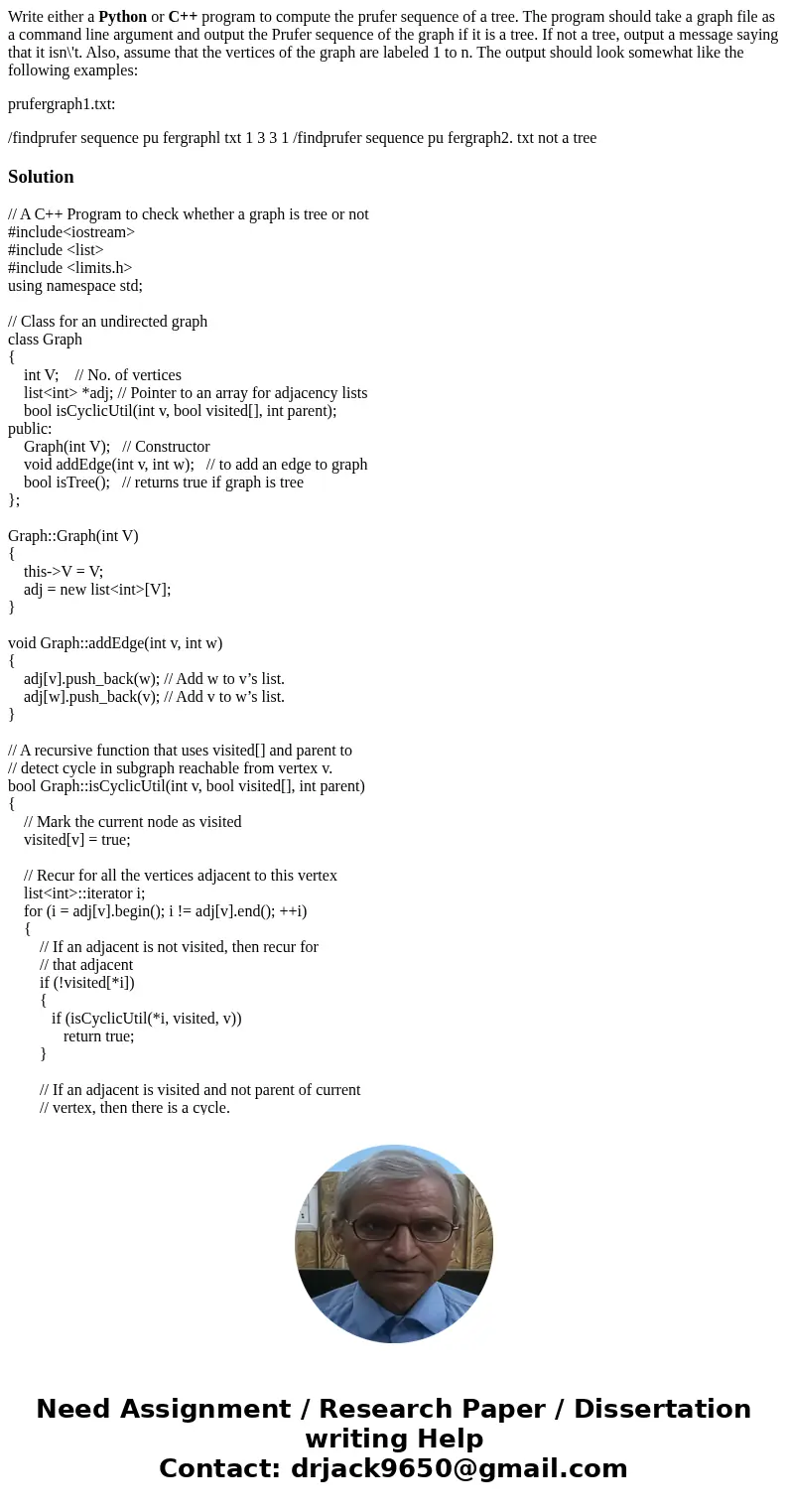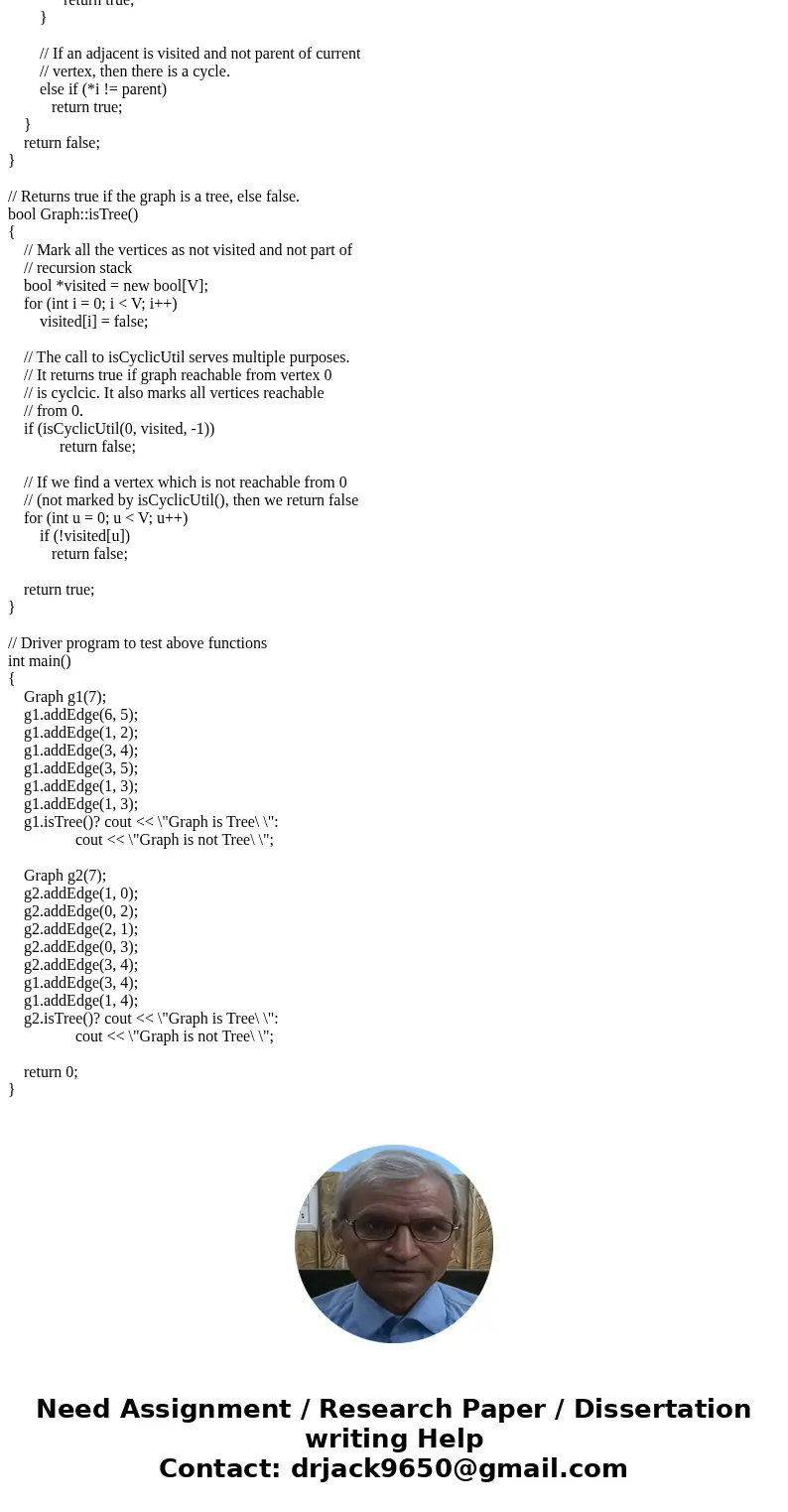Write either a Python or C program to compute the prufer seq
Write either a Python or C++ program to compute the prufer sequence of a tree. The program should take a graph file as a command line argument and output the Prufer sequence of the graph if it is a tree. If not a tree, output a message saying that it isn\'t. Also, assume that the vertices of the graph are labeled 1 to n. The output should look somewhat like the following examples:
prufergraph1.txt:
/findprufer sequence pu fergraphl txt 1 3 3 1 /findprufer sequence pu fergraph2. txt not a treeSolution
// A C++ Program to check whether a graph is tree or not
#include<iostream>
#include <list>
#include <limits.h>
using namespace std;
// Class for an undirected graph
class Graph
{
int V; // No. of vertices
list<int> *adj; // Pointer to an array for adjacency lists
bool isCyclicUtil(int v, bool visited[], int parent);
public:
Graph(int V); // Constructor
void addEdge(int v, int w); // to add an edge to graph
bool isTree(); // returns true if graph is tree
};
Graph::Graph(int V)
{
this->V = V;
adj = new list<int>[V];
}
void Graph::addEdge(int v, int w)
{
adj[v].push_back(w); // Add w to v’s list.
adj[w].push_back(v); // Add v to w’s list.
}
// A recursive function that uses visited[] and parent to
// detect cycle in subgraph reachable from vertex v.
bool Graph::isCyclicUtil(int v, bool visited[], int parent)
{
// Mark the current node as visited
visited[v] = true;
// Recur for all the vertices adjacent to this vertex
list<int>::iterator i;
for (i = adj[v].begin(); i != adj[v].end(); ++i)
{
// If an adjacent is not visited, then recur for
// that adjacent
if (!visited[*i])
{
if (isCyclicUtil(*i, visited, v))
return true;
}
// If an adjacent is visited and not parent of current
// vertex, then there is a cycle.
else if (*i != parent)
return true;
}
return false;
}
// Returns true if the graph is a tree, else false.
bool Graph::isTree()
{
// Mark all the vertices as not visited and not part of
// recursion stack
bool *visited = new bool[V];
for (int i = 0; i < V; i++)
visited[i] = false;
// The call to isCyclicUtil serves multiple purposes.
// It returns true if graph reachable from vertex 0
// is cyclcic. It also marks all vertices reachable
// from 0.
if (isCyclicUtil(0, visited, -1))
return false;
// If we find a vertex which is not reachable from 0
// (not marked by isCyclicUtil(), then we return false
for (int u = 0; u < V; u++)
if (!visited[u])
return false;
return true;
}
// Driver program to test above functions
int main()
{
Graph g1(7);
g1.addEdge(6, 5);
g1.addEdge(1, 2);
g1.addEdge(3, 4);
g1.addEdge(3, 5);
g1.addEdge(1, 3);
g1.addEdge(1, 3);
g1.isTree()? cout << \"Graph is Tree\ \":
cout << \"Graph is not Tree\ \";
Graph g2(7);
g2.addEdge(1, 0);
g2.addEdge(0, 2);
g2.addEdge(2, 1);
g2.addEdge(0, 3);
g2.addEdge(3, 4);
g1.addEdge(3, 4);
g1.addEdge(1, 4);
g2.isTree()? cout << \"Graph is Tree\ \":
cout << \"Graph is not Tree\ \";
return 0;
}


 Homework Sourse
Homework Sourse